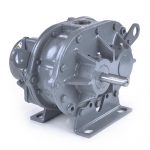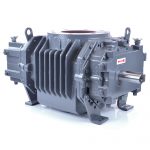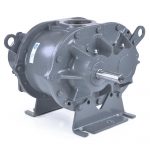Using Blower Names for Identification
Many positive displacement blower manufacturers use a common method to identify the frame size of a blower. Knowing what the frame size means, gives you a good first impression of the size and capabilities of that particular unit.
The two key elements that are identified in a typical frame size is nominal timing gear diameter and nominal impeller length. Knowing these two elements gives you and idea of the displacement (cubice feet per revolution) of the unit. What it won’t tell you is how much clearance is designed into the unit and therefore what its maximum ultimate pressure capability.
Most manufacturers use a 2, 3 or 4 place numeric system to identify a frame size. Typically, if a 2 place system is used such as 22, it would nominally mean 2″ nominal gear diameter and 2″ nominal impeller length. If a three place system is used, the 1st digit normally indicates a nominal gear diameter and the 2nd and 3rd place digits represents the nominal impeller length. If a four place system is used, the first two digits represent the nominal gear diameter and the last two digits represent the nominal impeller length.
Lets look at some example blower names:
- Roots Universal RAI frame 56 is 5″ nominal gear diameter and 6″ nominal impeller length
- Roots Universal RAI frame 711 is 7″ nominal gear diameter and 11″ nominal impeller length
- Sutorbilt 4500 Series 711 is 7″ nominal gear diameter and 11″ nominal impeller length
- ROOTSFLO Frame 409 is 4″ nominal gear diameter (actual diameter is 4.5″) and 9″ impeller length
- DuroFlow Frame 4509 is 4.5″ nominal gear diameter and 9″ impeller length
- MD Pneumatics Competitor Plus 5006 is 5″ nominal gear diameter and 6″ impeller length
Sometimes these numbers can throw you off a little. Consider a Roots Whispair Max Frame 2506. Is the nominal gear diameter 25″ or 2.5″? In this case it is a 2.5″ diameter. Most blower manufacturers start with an impeller length equal to or greater then the nominal timing gear diameter. While this is not always the case, it is true most of the time. Therefore the reasonable assumption is that the nominal gear diameter is 2.5″ and the impeller is 6″ in length.
The most common gear diameters currently in use, as of this writing are 2.5″, 3.5″, 4″, 4.5″, 5″, 5.5″, 6″, 7″, 8″, 9″, 10″, 12″, 14″, 16″, 18″, 20″ and 36″.
For a quick check of a unit’s size and displacement, the above guidelines should help with your blower identification. If you need further assistance, contact pdblowers. Our experienced team can help you identify old or obsolete units and provide repair or replacement services for most units. You can also upload a photo of your unit to assist with the blower identification.



